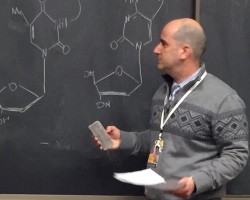You are here
Tracking Stem Cells After Infusion

Regenerative medicine is a new field of medicine that offers new hope for many patients. Stem cells have the capability to induce tissue repair and ultimately reverse the progression of many diseases. This field unveils new possibilities for the alleviation of many incurable diseases.
Treating diseases with stem cells is a powerful approach on three levels:
- Stem cells have the ability to migrate into the damaged tissue, replace the non-functioning cells and take over their function.
- Stem cells secrete small molecules that can prevent cell/tissue death, and help in recovery, or at least prevent deterioration of the tissue.
- Stem cells can be used as a vehicle for continuous delivery of therapeutic agents locally.
However, the major challenge today with translation of stem cell therapy into the clinic is that, after stem cells are infused, their fate is largely unknown. Therefore, it is critical to develop new imaging technologies that can non-invasively monitor the viability and the function of the transplanted stem cells in order to assess the success of the procedure and to ensure that the cells reach their intended destinations.
Medical imaging has revolutionized modern medicine as we know it. Essentially, no critical medical decision is taken today without performing some sort of imaging. Magnetic Resonance Imaging (MRI) is a powerful imaging tool that can be found in all major medical centers and is used both for diagnostics and for follow-up during and after treatment.
To address the need for visualization of transplanted cells, including but not limited to stem cells, scientists started in the early 90's to develop new technologies. Nanometer-sized magnetic particles (aka "nanoparticles") have been developed to track transplanted cells and have shown great success. Those nanoparticles are usually tiny iron crystal (or crystals of other metals with magnetic properties) wrapped with sugar-based polymers (to prevent toxicity). The nanoparticles can be inserted into stem cells in the lab. Next the stem cells can be injected into a human body and can be imaged with MRI.
Many pre-clinical studies in animals have shown the feasibility and safety of nanoparticles. Several clinical trials in humans were conducted around the world, showing the importance of tracking the cells in the body. The magnetic nanoparticles are mostly beneficial for tracking the location of cells, but are limited in providing additional information, such as whether the cells are dead or alive or actually performing the required function. This is because dead cells still maintain the particles, and thus, are still visible with MRI.
In the past decade, we have developed a unique technology in our lab to label transplanted cells with genetically encoded "reporters". By engineering the genome of the cells we wish to track, we can introduce molecules that can help us follow the cells with high-resolution MRI and monitor their viability. Since these reporters are encoded into the cell's own DNA, it ensures that the MRI signal we detect is only from live cells. These reporters can be used to tag certain cellular proteins to monitor their function.
Recently our artificial reporter genes were proven as beneficial tools in preliminary studies in laboratory animals. Armed with this new technology, and funding from the Maryland Stem Cells Research Fund (MSCRF), we aim to test the practicality of tracking stem cells in several disease models.
In summary, nanoparticles enable the non-invasive tracking of transplanted cells, and now, the new technology of reporter genes will allow us to monitor cellular viability and function as well. Due to the non-invasive nature of this method, and the abundance of MRI scanners in hospitals today, we anticipate that these innovative technologies can easily be translated into the clinic. This will enable clinicians to monitor the efficacy of regenerative medicine therapies for a large array of diseases, and consequently improve patient safety and treatment outcome.


